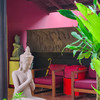Quan Thanh Temple: A Historical and Cultural Gem of Hanoi Overview Quan Thanh Temple (Đền Quán Thánh), also known as Tran Vu Temple, is one of Hanoi's oldest and most sacred Taoist temples. Established in the 11th century during the Ly Dynasty, it is part of the "Four Sacred Temples of Thang Long Citadel," guarding the northern entrance of the ancient capital. The temple is dedicated to Huyen Thien Tran Vu (Xuan Wu), the Taoist deity of the north, symbolized by a serpent and turtle. Located near West Lake at the intersection of Quan Thanh and Thanh Nien Streets, it remains a key spiritual and tourist site in Hanoi. Historical Significance - Founding: Built in 1010 under Emperor Ly Thai To to celebrate the relocation of Vietnam’s capital to Thang Long (modern Hanoi). - Sacred Role: One of four temples (alongside Bach Ma, Kim Lien, and Voi Phuc) positioned to protect the city from malevolent spirits and invaders. - Renovations: Restored multiple times, most notably in 1677 (when the iconic bronze statue was added) and 1893, blending Ly, Le, and Nguyen Dynasty architectural styles. Architecctural Highlights 1. Bronze Statue of Tran Vu: - Cast in 1677 by artisans from Ngũ Xã village, this 3.96-meter-tall, 3.6-ton black bronze statue depicts Tran Vu seated on a turtle, wielding a sword entwined by a serpent. It is Vietnam’s second-largest bronze statue and a masterpiece of 17th-century craftsmanship. - The deity’s symbols—the turtle (protection) and serpent (wealth)—reflect Taoist and Vietnamese folklore traditions. 2. Structural Features: - Three-Gate Entrance: Adorned with phoenixes and unicorns, typical of Nguyen Dynasty design. - Courtyard: Shaded by a centuries-old banyan tree, with a brick oven for burning joss paper during festivals. - Ancient Artifacts: Includes a 1.15-meter bronze bell, wood carvings of mythical creatures, and over 60 parallel poems in Chinese characters. Cultural and Spiritual Practices - Festivals: Locals visit during Tet (Lunar New Year) and on the 1st/15th lunar month days to pray for health, luck, and prosperity. - Syncretism: Though Taoist, the temple integrates Buddhist and Confucian elements, reflecting Vietnam’s religious blending. - Martial Arts: Hosts Vovinam classes, honoring Tran Vu’s association with martial prowess. Visitor Information - Location: 190 Quan Thanh Street, Ba Dinh District. - Hours: - Daily: 8:00 AM – 5:00 PM. - Extended hours on Tet Eve and lunar month days (6:00 AM – 8:00 PM). - Entry Fee: 10,000 VND (adults); 5,000 VND (students/children). - Dress Code: Modest attire covering shoulders and knees. Best Time to Visit: Early morning for tranquility, or during Tet (January–February) for vibrant rituals. Nearby Attractions 1. Tran Quoc Pagoda: Vietnam’s oldest pagoda, located on West Lake. 2. Ho Chi Minh Mausoleum: 1 km away, housing the embalmed leader. 3. Temple of Literature: Vietnam’s first university, dedicated to Confucius. Conclusion Quan Thanh Temple is a testament to Hanoi’s rich spiritual heritage and architectural ingenuity. Its iconic bronze statue, serene ambiance, and historical depth make it a must-visit for those exploring Vietnam’s cultural legacy. Whether admiring its artistry or participating in age-old rituals, the temple offers a profound glimpse into the soul of Hanoi. #travel #vietnam #hanoi #temple
Ice Lim 33
Popular Trip Moments
Popular Travel Types
Recommended Attractions at Popular Destinations
Bangkok attraction near me | Manila attraction near me | Tokyo attraction near me | Taipei attraction near me | Hong Kong attraction near me | Seoul attraction near me | Kuala Lumpur attraction near me | Los Angeles attraction near me | Shanghai attraction near me | New York attraction near me | Shenzhen attraction near me | Osaka attraction near me | Singapore attraction near me | London attraction near me | Guangzhou attraction near me | San Francisco attraction near me | Beijing attraction near me | Macau attraction near me | Bali attraction near me | Jakarta attraction near me | Paris attraction near me | Ho Chi Minh City attraction near me | Istanbul attraction near me | Phuket attraction near me | Chicago attraction near me | Seattle attraction near me | Toronto attraction near me | Orlando attraction near me | Cebu attraction near me | Chiang Mai attraction near me
Popular Attractions
Shenzhen Ping An Financial Center Yunji Sightseeing | Hanshan Temple | Black Diamond Swing Club | Itaewon-dong | Leifeng Tower | Statue of Guanyin | Ba Na Hills | The Huangpu River Cruise | Hoi An Old Town | Huanglong National Scenic Spot | Lingyin Temple | Eiffel Tower | Humble Administrator's Garden (Zhuozheng Garden) | Meridian Cruise | Centro de Ski Pucón | Escalators Through The Mountain | Sky Creek Ranch Golf Club | Roi Chan Phan Wang Waterfall | Bayswater Tennis Club | Shri Balaji Temple, Miraj | Walnut Park | Tukai temple | C.T. Barling Reserve Dog Off Leash Area | Riverfront Park Splash Pad | Football Club Syra | Les Herbes du Jardin mutin | Helbehaus | The stadium "Kolos" | Shanghai Tower | Sanxingdui Museum
Popular Ranked Lists
Top 4 Best Things to Do in Guigang | Top 4 Local Restaurants in Mangshi | Top 10 Local Restaurants in Baoding | Top 10 Local Restaurants in Huizhou | Popular Premium Hotels in Mobile County | Top 10 Local Restaurants in Jiangmen | Popular Best Things to Do in Lvliang | Top 10 Local Restaurants in Wuyuan | Popular Best Things to Do in Xinchang | Popular Luxury Hotels Near Sandakan Division | Popular Best Things to Do in Wudalianchi | Popular Premium Hotels in Karagandy | Popular Premium Hotels in Torquay | Popular Luxury Hotels Near Goslar | Top 10 Best Things to Do in Hechi | Top 10 Local Restaurants in Lingshui | Top 3 Best Things to Do in Panzhihua | Popular Luxury Hotels Near Odiaxere | Popular Best Things to Do in Jishou | Popular Luxury Hotels Near Phuc Yen | Top 3 Best Things to Do in Chizhou | Popular Premium Hotels in Mbabane | Popular Premium Hotels in Durango | Popular Luxury Hotels in Ramatuelle | Top 3 Best Things to Do in Tonghua | Top 4 Best Things to Do in Dongfang | Popular Best Things to Do in Xing'an County | Popular Best Things to Do in Yangquan | Popular Premium Hotels Near Samosdelka | Top 6 Best Things to Do in Ji'an
Payment Methods
Our Partners
Copyright © 2025 Trip.com Travel Singapore Pte. Ltd. All rights reserved
Site Operator: Trip.com Travel Singapore Pte. Ltd.
Site Operator: Trip.com Travel Singapore Pte. Ltd.











